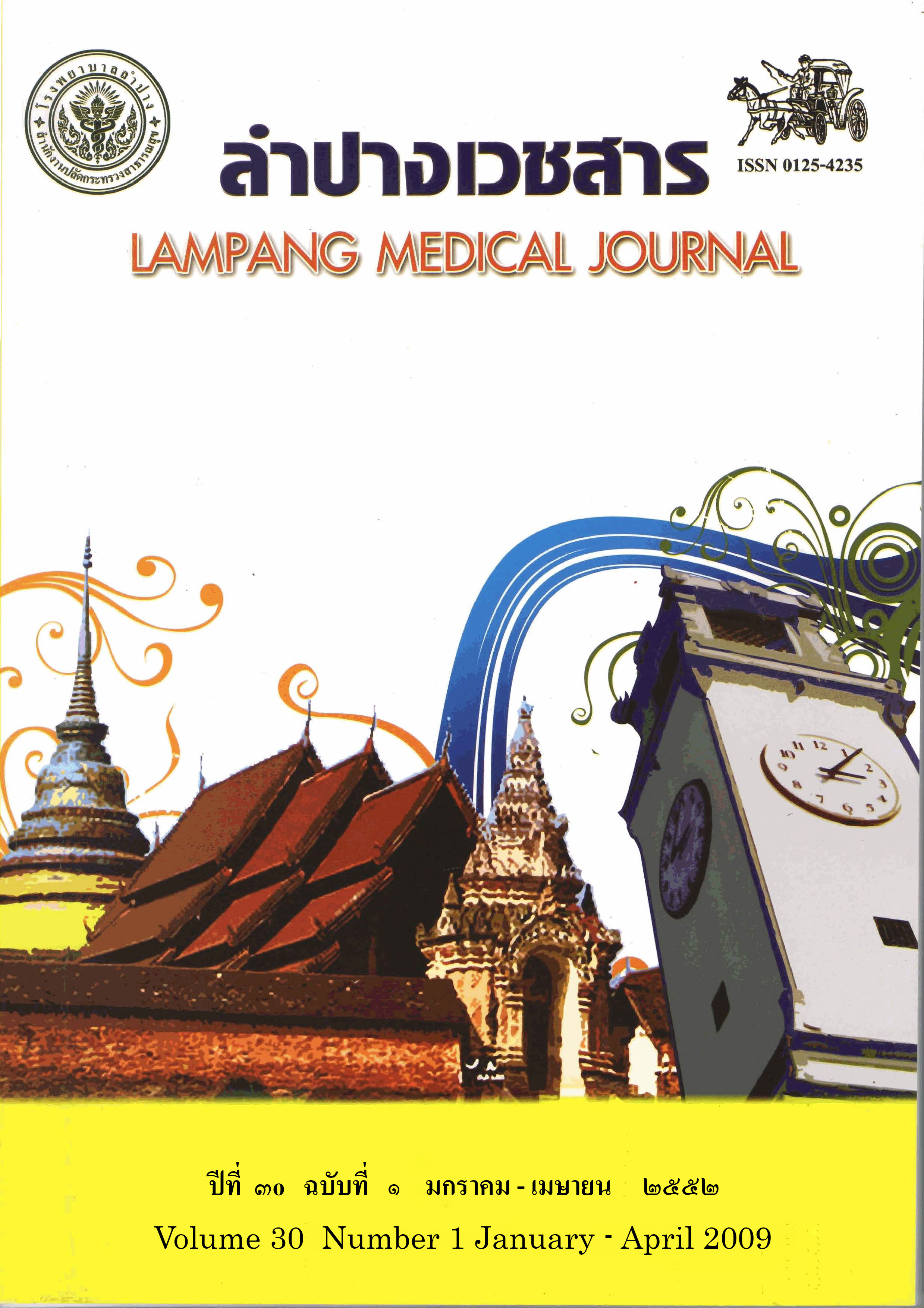Needle Stopper after Arterial Blood Gas Sampling Comparison between Clay and Rubber Cap
Main Article Content
Abstract
Background: During the arterial blood gas (ABG) sampling process , a rubber cap is commonly used to be a needle stopper for preventing air leakage. This recapping step takes risk for needle injury of healthcare workers. The author has invented the clay cap to reduce this risk.
Objective : To compare two types of needle stopper, between a clay cap and a rubber cap, during ABG sampling process in term of healthcare workers’ satisfaction.
Material and method : Cross sectional analytical study was conducted in two groups of population; provider and user. The provider group consisted of 55 nurse-aids. The user group comprised 81 ICU nurses, 22 medical students and 7 laboratory technicians. All of them were demonstrated the assembly and operating technique of both types of needle stopper till clearly understand. After 2 weeks of practice, the subjects evaluated their satisfaction and selected the stopper type they preferred. The data
was analyzed by chi-square test.
Results : In the provider group, most of nurse-aids significantly preferred clay cap than rubber cap in term of its ease of use, safety and assembly technique (p <0.05). In the user group including all of laboratory technicians, most of ICU nurses and medical students significantly preferred clay cap for its ease of use, safety and operating technique. Finally all groups of population predominantly selected the clay cap to be stopper of choice significantly more than rubber cap, i.e. 67.3% of providers, 92.6% of ICU nurses, 90.9% of medical students and 100% of laboratory technicians (p <0.05).
Conclusion : The clay cap was more appropriate than rubber cap for being needle stopper during ABG blood sampling. Both provider and user satisfied and preferred its ease of use and safety. The clay cap should be used to reduce the risk of needle injury in healthcare worker
Article Details

This work is licensed under a Creative Commons Attribution-NonCommercial-NoDerivatives 4.0 International License.
บทความที่ส่งมาลงพิมพ์ต้องไม่เคยพิมพ์หรือกำลังได้รับการพิจารณาตีพิมพ์ในวารสารอื่น เนื้อหาในบทความต้องเป็นผลงานของผู้นิพนธ์เอง ไม่ได้ลอกเลียนหรือตัดทอนจากบทความอื่น โดยไม่ได้รับอนุญาตหรือไม่ได้อ้างอิงอย่างเหมาะสม การแก้ไขหรือให้ข้อมูลเพิ่มเติมแก่กองบรรณาธิการ จะต้องเสร็จสิ้นเป็นที่เรียบร้อยก่อนจะได้รับพิจารณาตีพิมพ์ และบทความที่ตีพิมพ์แล้วเป็นสมบัติ ของลำปางเวชสาร
References
โรงพยาบาลลำปาง. งานป้องกันและควบคุมการแพร่กระจายเชื้อ. รายงานประจำปี ร้อยละของบุคลากรประสบอุบัติเหตุถูกของมีคมที่ปนเปื้อนสารคัดหลั่งของผู้ใช้บริการทิ่มตำต่อบุคลากรกลุ่มเสี่ยง. ลำปาง ; 2550. หน้า. 19-21.
Rapiti E, Pruss-Ustin A, Hutin Y. Sharp injuries : assessing the burden of disease from sharps injuries to health-care workers at national and local levels. Geneva : World Health Organization; 2005. p. 8-44.
Schulte P, Stephenson C, Okun A, Palassis J, Biddle E. Integrating occupational safety and health information into vocational and technical education and other workforce preparation programs. Am J Public Health 2005; 95: 404-11.
Kiertiburanakul S, Wannaying B, Kehachindawat P, Somsakul S. Use of HIV postexposure prophylaxis in healthcare workers after occupational exposure : a Thai university hospital setting. J Med Assoc Thai 2006; 89: 974-8.
Gershon R, Flanagan P, Karkashin C, et al. Health care worker’s experience with postexposure management of blood borne pathogen exposure : a pilot study. Am J Infect Control 2000; 28: 421-8.
Richard V, Kenneth J, Ramaprabha P, Kirupakaran H, Chandy G. Impact of introduction of sharps containers and of education programmes on the pattern of needle stick injuries in a tertiary care centre in India. J Hosp Infect 2001; 47: 163-5.
Benson C, Kosinski A. Needle stopper and needle removal device. J Pat Off Soc 1996; 16 : 9-23.
Mitaishvili R. Capillary blood gas sampling for neonatal & pediatric patients. Respir Care 2001; 46: 506–13.
Guggenheim S, Martin R. Definition of clay and clay mineral : journal report of the AIPEA nomenclature and CMS nomenclature committees. Clays Clay Miner 1995; 43: 255–6.


